The artistic and life partnership of Anne and Patrick Poirier (Marseilles, 1941; Nantes, 1942) began more than fifty years ago when, winners of the Gran Prix de Rome while they were students at the École Nationale Supérieure des Arts Décoratifs, they stayed at the French Academy of Villa Medici in Rome from 1968 to 1972. The temple of Hadrian, the Domus Aurea and the ruins of ancient Ostia were inextricably sculpted in their imagination, suggesting their creative identification with an architect and an archaeologist to continue their studies in the field. This operation was the trigger and the leitmotif of their varied and continuous artistic production, which has always been fueled by an interest in history and urban research, both used as tools to detect what remains of the past in the present. Ruin, therefore, is seen not so much in a nostalgic sense, but as a survival that manages to reach the present thanks to its intrinsic ability to be an active agent in generating new universes of thought.
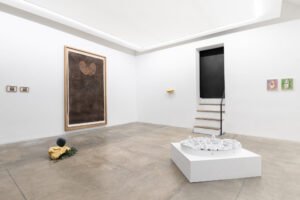
Anne and Patrick Poirier, Apoptosi, exhibition view. Photo Francesco Rucci, courtesy the artists and Galleria Studio G7, Bologna
From a stylistic point of view, the experience of the two artists, who have refused to identify themselves with a specific medium right from the start, is halfway between the “quotationist” experiences from the 70s and 80s, the post-conceptual neoclassicism by Paolini and the monumentalism typical of much sculpture from the 1980s. Exploiting the most diverse timbres (material, environmental and literary) Anne and Patrick Poirier endlessly combine tried-and-tested forms from the classical tradition, natural elements and writing to develop an analytical and self-referential discourse on art, which is, at all times of its history, contemporary to all the moments that make up that same history. The Apoptosi exhibition, which has just opened at the Studio G7 gallery in Bologna, offers a precious opportunity to closely examine the poetics of these two masters of contemporary art through a selection of historical, recent and unpublished works, specifically representative of the themes and expressive registers of the couple. The concept of apoptosis, which defines a particular biological process by which a living organism regenerates itself through the programmed death of some of its cells, identifies as a constant throughout the production of the French duo a kind of “practice of rebirth” linked to the visualization of the succession in the history of humanity of civilizations that ceaselessly die to be replaced by others. The attitude to stratification that unites the exhibited works can be traced back to this process, suggesting how the artists, by manipulating the remains of what seems destined to disappear, subtract these fragments of matter and time from the irremediability of dispersion, reactivating their imaginative and tangible potential.
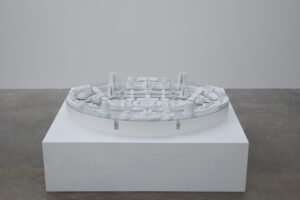
Anne and Patrick Poirier, Mnemosyne, 1990-2022, white resin, acrylic mirror, acrylic paint, 100 x 80 x 25 cm, courtesy the artists and Galleria Studio G7, Bologna
The exhibition path ideally starts with Mnemosyne (1990-2022), a sculptural project of an ideal city dedicated to the goddess of memory and mother of the Muses, which Anne and Patrick Poirier launched in France unaware of the convergence of their intuitions with those of the homonymous Atlas (1924– 29) by Aby Warburg, an author on whom the artists recall bore the hostility of French criticism, which for many years hindered the translation and circulation of his writings. What we see at Studio G7 is a small-scale edition of an elliptical environmental architectural installation that imagines a Library capable of enclosing human knowledge in its entirety, a temple of the future in which all memories and knowledge, without hierarchical distinctions, can coexist in an integrated way. The structure, divided into two parts that can be traced back to the distinction between practical-technical and theoretical knowledge, in its declared reference to the shape and functionality of the brain reveals itself as an effective transition device between the macro and micro dimension, in which the brain shape is both the foundation of a universal urban planning and the intimate melting pot in which the individual self is created.
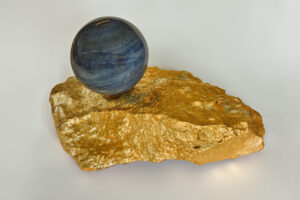
Anne and Patrick Poirier, Cosmos, 2017, river stone collected at Thoronet Abbey gilded with gold leaf, lazarite sphere, 35 x 25 x 20 cm, stone diameter 16 cm, courtesy the artists and Galleria Studio G7, Bologna
As Leonardo Regano’s critical text underlines, the anatomy of the brain also returns «in the two hemicycles of the lotus leaf page that stands out against the dark background in Angkor (2009) », a reminder of a trip to Cambodia where the couple ventured immediately after the first stay in Rome, when the bloody civil war between the Communist Party of Kampuchea allied with the Vietcong and the national government forces, supported by the United States of America and South Vietnam, had emptied the country of scholars and visitors. Years later, the inclusion of that find in a smoky pictorial surface like the melee of a battlefield metabolizes the memory of that experience into a moving metaphor of the destiny of transience and instability to which the human species is doomed. The sensitive internalization of the fragility that unites collective history and the natural universe is, moreover, at the origin of the ecological concerns which, since the residence at Villa Medici, have marked the poetics of the two artists, inspiring them the practice of taking, conservation and reproduction of plant elements which is still one of the characterizing trends of their research. In both areas their interventions have the double value of protecting what has survived from the aggression of time and of transmitting to the future the continuity with the past which constitutes its founding prerequisite.
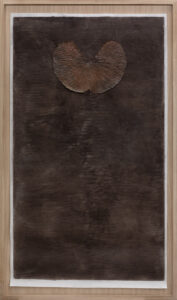
Anne and Patrick Poirier, Angkor, 2009, canson paper, charcoal, lotus leaf, 250 x 145 cm, courtesy the artists and Galleria Studio G7, Bologna
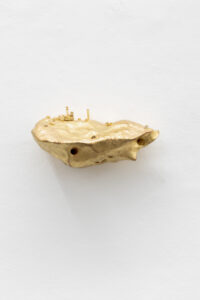
Anne and Patrick Poirier, Sogno, 2017, gold leaf gilded stone, gilded plaster, 28 x 14 x 17 cm, courtesy the artists and Galleria Studio G7, Bologna
In the exhibition we find different variations of the insertion of nature finds in the works, expression of an osmotic graft between the personal dimension of the journey, in which the physical exploration of the world flows into an enchanted intellectual flânerie among the classics of the humanities and the choral perspective of history. The linking function between these two different extensions of human existence is guaranteed by writing, another typical modality of their creative process, which recurs depending on the case in the form of a diary, literary quotation, poetic annotation or synthetic identification of geographical and time coordinates. Here too there is a sort of collection of impressions aimed at preserving a memory in which the intimate and autobiographical component connected to the occasion of the discovery expands until it assumes an exemplary prominence.
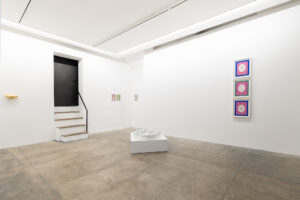
Anne and Patrick Poirier, Apoptosi, exhibition view. Photo Francesco Rucci, courtesy the artists and Galleria Studio G7, Bologna
In the large Journal d’Ulysse (2021) unpaged and installed on the wall, the artists associate souvenirs of their daily morning walks, such as dried leaves or bird feathers (fixed on paper in the center of once again elliptical shots), with reflections arising during the path in the encounter with the chosen objects and specific chromatic combinations that visually summarize the unrepeatable emotional tone of each day. The encyclopaedic vocation of this project, which leads the trace of individual memory back to a mythological exploration of the existent of which the tireless wandering of Ulysses is the emblem, is diluted in the beautiful series entitled Graffio poetico (2022). Each artwork has as its protagonist the photographic enlargement of a flower petal on which an always different inscription appears, created by injecting the ink into the vegetable material. The photographs testify to the different degrees of absorption of the artificial color which expands as a more or less marked halo around the words and spreads in the veins of the petals replacing the natural sap, of which it brings out the conducting vessels.
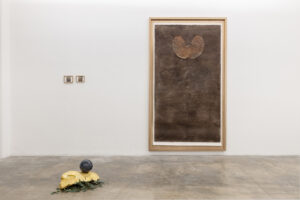
Anne and Patrick Poirier, Apoptosi, exhibition view. Photo Francesco Rucci, courtesy the artists and Galleria Studio G7, Bologna
In the stereoscopic images that make up Gradiva (2000), of which we see on display the last two works still available on the market, clouded shots of the bank of the Seine devastated by the flood that occurred in 2000 and the mysterious silhouette of a hooded woman taken from the homonymous novel by Wilhelm Jensen overlap. In the story a young archaeologist, struck by a bas-relief depicting an ancient girl caught in the act of walking, fantasizes that she comes from Pompeii and that she lived in the period before the eruption of Vesuvius. The grafting of this dreamlike figure (already taken up in various ways by Freud, Dalí, Masson, Breton, Barthes and Leiris) in the real landscape, which the blurring in turn projects into a diachronic time, reactivates its survival in the present by making explicit that integration between archaeological time and psychic time which is perhaps the most effective agent of poetic transformation of the French duo’s investigation method.
Info:
Anne and Patrick Poirier. Apoptosi
critical text by Leonardo Regano
24/01 – 08/04/2023
Galleria Studio G7
Via Val D’Aposa 4A, 40123, Bologna
https://www.galleriastudiog7.it/
Graduated in art history at DAMS in Bologna, city where she continued to live and work, she specialized in Siena with Enrico Crispolti. Curious and attentive to the becoming of the contemporary, she believes in the power of art to make life more interesting and she loves to explore its latest trends through dialogue with artists, curators and gallery owners. She considers writing a form of reasoning and analysis that reconstructs the connection between the artist’s creative path and the surrounding context.






NO COMMENT